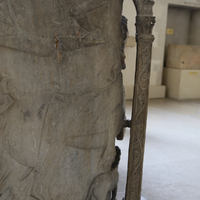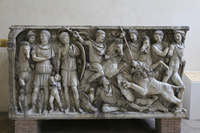Sarcophagus of Jovinus
Type:
Sarcophagi
Date:
370,
265
Medium:
Marble
Dimensions:
1.48 × 2.85 × 1.33 m
Description:
Flavius Valerius Jovinus was the leader of the Roman army in Gaul (France) when he defeated the Germanic Alamanni in 367. When he returned to Rome to be honored for his victories (he was named consul), he acquired a marble sarcophagus carved a century earlier (ca. 265) and had its principal figures recarved with his own likeness. Jovinus was probably born in Reims (Roman Durocortorum), and he died there in 370 after converting from paganism to Christianity. He built the first church at Reims, dedicated to Saints Agricola and Vitalis, which housed his tomb; that church was later replaced by Saint-Nicaise.
On the front of the sarcophagus, carved in high relief, the short-haired, beardless Jovinus prepares for the hunt and then confronts a menacing lion, a boar, and human enemies with long hair, mustaches, and sideburns. The sides are carved in low relief, as is typical of Roman sarcophagi, which were meant to be placed against the wall of a tomb.
The sarcophagus was reused for the burial of the Frankish king Carloman, a younger brother of Charlemagne, who died in 771. The iconography of a military leader defeating fierce beasts was often employed for rulers in ancient and medieval art.
On the front of the sarcophagus, carved in high relief, the short-haired, beardless Jovinus prepares for the hunt and then confronts a menacing lion, a boar, and human enemies with long hair, mustaches, and sideburns. The sides are carved in low relief, as is typical of Roman sarcophagi, which were meant to be placed against the wall of a tomb.
The sarcophagus was reused for the burial of the Frankish king Carloman, a younger brother of Charlemagne, who died in 771. The iconography of a military leader defeating fierce beasts was often employed for rulers in ancient and medieval art.
Relevant Textbook Chapter(s):
1,
2
Repository and Online Resources:
• See the description of the sarcophagus (in French) on the website of the Musée Saint-Remi, Reims.
Image Credits:
Linda Safran

































